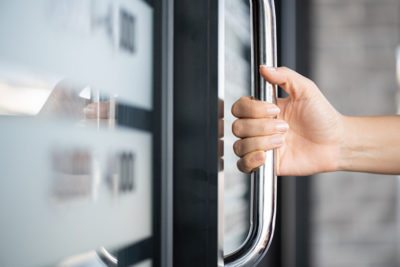
The horrific elementary school shooting in Uvalde, Texas, where the gunman was able to enter through an unlocked door (due to a mechanical error), once again displayed the vital importance of adequate door security and the basic practice of keeping doors locked when not staffed by trained personnel.
In our Jewish institutions, this may feel counterintuitive. The Torah instructs us to keep our doors open to those in need and embrace the Jewish credence of hospitality, a la Abraham and Sarah’s tent, open on both sides, ready to welcome strangers. How do we come to terms with locking our houses of worship and other Jewish buildings like fortresses?
In recent years we Jews have felt relatively safe and confident coming together to pray, learn, or just gather informally. However, the rise in antisemitism reveals that it’s now time to “batten down the hatches,” so to speak, to ensure our community’s safety.
Here are some simple and inexpensive steps you can employ to implement door security at your synagogue or other building:
- No matter how many doors you have, only one should be appointed as a throughway for entering or exiting services or events, and this door should be staffed by someone who knows the community and how to recognize and respond to threatening situations. Remember, the more entrances you have the more difficult to monitor and control them. All other doors should be equipped with exit-only locking mechanisms in the event of evacuations.
- Locks need to be effective and tested regularly, and doors should never be propped open or have anything blocking their path. If possible, install electronic locking systems that can be activated without a key.
- Try to implement electronic access control in and out of the building, equipped with an intercom and key fobs to allow seamless entry but elevated security on a day-to-day basis.
- Discuss the need for these procedures with your community and involve them in the safety and security conversation. This will ensure greater buy-in and an understanding of security measures.
Remember, doors are a building’s first line of defense. Locked doors can deny a perpetrator’s access or, at the very least, delay their entry, giving those inside time to alert the authorities and make their way to safer spaces. Locked and guarded doors also give the appearance of a “hard target,” which alone can deter attackers from attempting an assault.
As past events have shown us, no matter how good your security plan or active-shooter drills are, if your doors are open, you’re a target. But locked doors mitigate these risks. In Halle, Germany, in 2019, a gunman tried to enter a busy synagogue on Yom Kippur. His own live-streaming footage shows him pushing on the locked synagogue door as well as firing several shots at the lock and trying to use an explosive to disarm it. After realizing his attempts were futile, he got back into his vehicle and drove away. The 70 to 80 members inside were spared due to excellent door security.
Ultimately, fulfilling the mitzvah of an open-door policy is just not safe these days, but showing congregants that their safety and security is taken seriously is very welcoming indeed.

